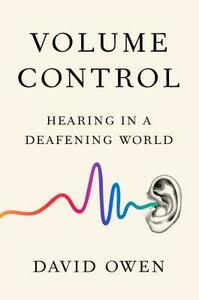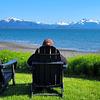Take a photo of a barcode or cover
I’ve never been as paranoid with the volume settings as I was in listening to this audiobook. Volume Control is all about our hearing covering the science of how we hear to the history of how humans have tried (and mostly failed) to protect their hearing, to current cutting edge advancements in assisting deaf and hard of hearing treatments & technology. It’s consistently interesting and has a lot of tidbits related to the topic. The author is rightfully concerned about hearing protection around power tools – luckily I have always had my trusty earplugs and even ear muffs on top when operating a router. Now I just have to remember to turn down the volume on my ear buds listening to audiobooks and podcasts as well.
It's got three things going for it. A Bill Bryston-style stroll through the history and science of hearing loss. An expose of the shady hearing aid industry. And a warning that we subject ourselves to more hearing damage than we realize.
Excellent book for anyone interested in hearing and hearing loss. Discusses history and new technologies as well as ways hearing impacts daily life.
DNF: Just wasn't what I was looking for. There is a lot of research being done about the damage our increasingly noisy world can do. This was more about how people cope with hearing loss. There were too many personal accounts for it to be a compelling science-based read, and too much science for it to be emotionally engaging. I tired of it quickly.
informative
fast-paced
informative
inspiring
medium-paced
informative
fast-paced
informative
medium-paced
Well-researched, highly informative, and engagingly written. I've always been protective of my hearing but now I'm even more so, and I feel justified in having been "over the top" about loud noise in the past.
The book addresses hearing damage, hearing loss (congenital and acquired), hearing aids, hearing protection, cochlear implants, the history of Deafness (and the difference between deaf and Deaf), and the social impacts of deafness.
The book addresses hearing damage, hearing loss (congenital and acquired), hearing aids, hearing protection, cochlear implants, the history of Deafness (and the difference between deaf and Deaf), and the social impacts of deafness.
Yes, once in a while I do read non-fiction. In this case, it's all about hearing. The causes of hearing loss, some helps for hearing loss, the ways people cope, the medical research, and so forth. All things hearing. It's a fairly extensive coverage of the topic of hearing.
The one big problem, I think is that there are no damn pictures! So we get extensive attempts to tell us in words about the physiological structures that enable us to hear, and the ways people try to mitigate hearing loss, both by gadgets, like hearing aids (what I'm doing), and by surgical means, like cochlear implants.
Well, ya know? A couple of pictures would really, really have helped me better to envision what's going on. Yes, I can Google it all, but why read the book then? I'm a bit disappointed in it all. Hence, I took a half * off the score because of the lack of pictures.
The one big problem, I think is that there are no damn pictures! So we get extensive attempts to tell us in words about the physiological structures that enable us to hear, and the ways people try to mitigate hearing loss, both by gadgets, like hearing aids (what I'm doing), and by surgical means, like cochlear implants.
Well, ya know? A couple of pictures would really, really have helped me better to envision what's going on. Yes, I can Google it all, but why read the book then? I'm a bit disappointed in it all. Hence, I took a half * off the score because of the lack of pictures.
The sense of hearing has recently become a subject of interest to me. We bombard ourselves with a cacophony of noise everyday, especially now with our generation that has its AirPods plugged inti our head more often than not while at work or working out. To make sense of where my and our generation’s hearing was headed, I picked up this book.
David Owen puts his research and own hearing disability to bear by walking the reader through the anatomy of the ear, the discovery and reasons for hearing’s failure and the past, present and future of hearing disability accommodation and possible treatments.
Overall, his science lands well to the novice audiologist. He explains sound as vibrations that are corralled by the outer hear before the three inner hear bones transfer the energy to mechanical energy for the cochlea then relayed to nerves to be interpreted by the brain. This explanation precedes an evolutionary biological explanation for how we developed our hearing.
The fragility of hearing is only a recent discovery as accounts are paraphrased how laborers, soldiers and common folk began to have their hearing investigated and tested. In this section, Owen makes an interesting note on how sight and blindness often attracts higher investment and attention than hearing.
Owen’s writing suffers when he goes into his own personal dealings with tinnitus. Its not really his facts but more own his humor just seems too dad-joke like. Regardless, he does not hold back on how the hearing aid business has become fraudulent and big business. He also muses over how our society could be more accepting of the deaf with education systems that taught ASL early rather than late in a death child’s life as early recognition and intervention stories are expose’d. Finally, he unravels how hearing loss can in fact be conductive from one singular loud event like a gunshot or loud concert. Remedies are being developed to not just assist the ear in capturing sound like a gearing aid does but rather improving the connection between the synapses in the brain.
All in all, Owen’s sources are reputable and arguments are valid. His reports on how our hearing is being further challenged and improved have provoked me to give greater consideration to ear plugs and to the deaf. Finally, his best observation comes from his comparison of sight and hearing. Sight is the sense where we connect with our environment but more importantly, hearing connects us with others and is what gives us our human connections.
David Owen puts his research and own hearing disability to bear by walking the reader through the anatomy of the ear, the discovery and reasons for hearing’s failure and the past, present and future of hearing disability accommodation and possible treatments.
Overall, his science lands well to the novice audiologist. He explains sound as vibrations that are corralled by the outer hear before the three inner hear bones transfer the energy to mechanical energy for the cochlea then relayed to nerves to be interpreted by the brain. This explanation precedes an evolutionary biological explanation for how we developed our hearing.
The fragility of hearing is only a recent discovery as accounts are paraphrased how laborers, soldiers and common folk began to have their hearing investigated and tested. In this section, Owen makes an interesting note on how sight and blindness often attracts higher investment and attention than hearing.
Owen’s writing suffers when he goes into his own personal dealings with tinnitus. Its not really his facts but more own his humor just seems too dad-joke like. Regardless, he does not hold back on how the hearing aid business has become fraudulent and big business. He also muses over how our society could be more accepting of the deaf with education systems that taught ASL early rather than late in a death child’s life as early recognition and intervention stories are expose’d. Finally, he unravels how hearing loss can in fact be conductive from one singular loud event like a gunshot or loud concert. Remedies are being developed to not just assist the ear in capturing sound like a gearing aid does but rather improving the connection between the synapses in the brain.
All in all, Owen’s sources are reputable and arguments are valid. His reports on how our hearing is being further challenged and improved have provoked me to give greater consideration to ear plugs and to the deaf. Finally, his best observation comes from his comparison of sight and hearing. Sight is the sense where we connect with our environment but more importantly, hearing connects us with others and is what gives us our human connections.



